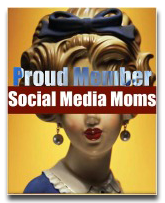I received an email today that had the subject line: Does Reading Matter?
And I got all hot and bothered about it because yes, of course reading matters. It matters a lot. Trust me, I haz opinions on this subject.
Turns out, the email’s author has opinions on the matter too, and sent me a lovely article outlining them. It’s well worth your time, with some fresh reading recommendations in there, to keep you occupied while I gather my own feverishly opinionated post together.
(First, feast your eyes on this photo of Cass reading back in 2011, when she was 7. Be still my beating heart; where’d my little girl go?)

Does Reading Matter?
By Chantal Jauvin
With April upon us, thousands of families are starting to negotiate what they will do for their summer vacations. The stakes are high: Wi-Fi or not? Together or separately? Away camps or day camps? Parents, children, couples, relatives and friends, vying to create their perfect version of a summer holiday.
The choices have multiplied to such an extent that the option of simply dropping by the local library to pick up a stack of books for the cottage, the park or the backyard seems a distant memory. People bemoan their lack of time to read. The reasons are endless: work, chauffeuring the kids, barely enough time for yoga, tax season, too much time looking at the computer screen, and the new season of House of Cards. In other words, life gets in the way of reading.
So, why do we shortchange our reading time? Does reading still matter?
Most people would agree that being able to read matters. Yet as many as 32 million adults in the U.S. cannot, according to the U.S. Department of Education figures from December 2015. But there is an even more alarming statistic: 19% of high school students graduate without being able to read. These statistics raise some alarming questions: Do we have enough jobs to employ so many illiterate people? Will those jobs pay sufficiently to keep them out of poverty?
If we stretch our vision to look at the state of global literacy, the same research found that 775 million people around the world cannot read. Because some cultures still place less value on girl’s formal education while their brothers are encouraged to attend school, females account for 66% of that number. Whether at home or abroad, the ramifications of illiteracy are obvious: poverty, social exclusion and limited access to medical care.
The statistics can be argued with, reframed or countered. The simple fact remains: illiteracy severely limits quality of life both in economic terms and in the possibilities of enjoyment. Parents, advocates, government officials, students may not agree on how to fix the problem, but everyone agrees that the ability to read beyond a basic level is crucial.
Americans spend 2 hours and 46 minutes out of each day watching television. Young adults between the ages of 15 and 19 spend only 4.2 minutes per day reading during weekends and holidays (excluding homework-related reading). Reading habits increase only marginally later in life. Americans ages 45 to 54 engage in leisure reading only 26.4 minutes a day, (American Time Use Survey, 2013).
If we agree about the importance of reading, why do spend so little time enjoying it? The reasons vary by person, but perhaps the root cause has more to do with our cost-benefit analysis of the use of our time. A regular workout regime, say 3 times a week, 45 minutes each session, provides a tangible result. Reading’s benefits are less obvious.
Huffington Post has taken a look at the science behind reading and offers us concrete reasons to read more often. “6 Science-Backed Reasons to Go Read a Book Right Now” include:
- Stress reduction: It takes only 6 minutes of reading to begin lowering your stress level.
- Longer-lasting memory function: People who start to read early and continue to do so throughout their lives experience slower memory decline.
- Better sleep: Sleep experts recommend reading before bed to improve the quality of sleep.
Science aside, there are some other compelling reasons to read more often.
1. To learn from history.
Reading historical fiction provides insights into our past. Reading about Queen Isabella’s rule in Spain through the eyes of author C.W. Gortner in The Queen’s Vow provides a compelling way to understand the events and personalities who ruled this country in this period.
2. To prepare for action.
In this age of instant gratification, books are our 24-hour-a-day teachers. They are available to help us plan a trip, learn a new skill or face a personal challenge. They provide privacy to test ourselves by taking self-help quizzes or improving the way we face life. Consider Amy Cuddy’s new book Presence: Bringing your Boldest Self to your Biggest Challenges.
3. To boost imagination and creativity.
A book can provide a different perspective on life. Lee Miller: A Life by Carolyn Burke challenges the reader to see the world through the lens and life of a talented photographer. People who suffer from isolation often find solace when they encounter a character who shares their values and experiences. This affirmation validates their views and often spurs their creativity.
4. To increase our empathy.
Our world faces constant challenges requiring us to empathize with people facing situations we ourselves have not encountered. That Bird Has My Wings by Jarvis Jay Masters depicts the journey of a man on death row. Books bridge the gap between situations unknown to us and universal themes of our human condition: struggles with faith, self-forgiveness and judgment of others.
5. To be a responsible citizen of the world.
Margaret Atwood explains this best: “Reading and writing, like everything else, improve with practice. And, of course, if there are no young readers and writers, there will shortly be no older ones. Literacy will be dead, and democracy – which many believe goes hand in hand with it – will be dead as well.”
It’s always the right time to do something good for your health, your mind, your soul. But summer is an especially opportune occasion, which provides us more open space in our lives. Fill that space with something that matters; have a summer fling with reading, and see where it goes.
Chantal Jauvin is an international attorney who has combined her passion for experiencing other cultures with her pursuit of a global legal career. She has lived in Japan, Mexico, Cambodia, Russia, Austria, taking shorter assignments in Vietnam while pursuing her MBA studies in the UK. She has negotiated in Paris, Buenos Aires, and Sao Paulo often enough to almost call these cities home. Igniting her lifelong enthusiasm for language and other societies, she has turned her attention to writing in her quest to understand how our souls are touched by the blended world in which we live. Jauvin currently resides with her husband in Philadelphia, Pennsylvania.
Her new book The Boy with a Bamboo Heart tells the story of a street orphan who created a children’s charity called FORDEC. The book can be purchased on Amazon and ChantalJauvin.com
Connect with Chantal Jauvin on LinkedIn, Facebook , and on her website, http://chantaljauvin.com/. For more information on FORDEC, please visit http://fordecusa.org/.
read more
Not too terribly long ago I participated in the Timex ONE relay and in spite of the fact that I am honestly just a terrible runner, it felt pretty awesome to be part of such a huge endeavor. It’s simply amazing: the sheer number of people involved, the heart of the participants and the ongoing support of the running community.
Now here’s your chance to take part: in not just a national relay, but a historic running relay!
The United Relay of America is making running history as the world’s first triple-route coast-to-coast nonstop running relay. Runners who want to make a difference will set off from Seattle, San Francisco and Los Angeles, and meet in New York City, carrying three batons nearly 12,000 miles in the three unbroken chains. In the process, awareness and an estimated $1.5 million will be raised for several deserving charities, including children’s hospitals across the nation.
Between those three unbroken chains, an estimated 9,000 runners will run over 1,200 stages in 39 days (setting off from Seattle on April 27th, San Francisco on May 4th and LA on May 8th). They’ll then move east, with the last runners uniting at Prospect Park, New York City on June 4th. That’s about 12,000 miles across 33 states! You can follow the runners’ progress on a live map or by following along on social media.
To participate, register to run a stage on the United Relay of America website (individual stage is $50, group stages are $25. One group stage involved the “Rocky steps” at the Philly art museum, on June 2nd). You’ll then be invited to choose a charity and a fundraising target. Fundraising is not compulsory; if you don’t hit your target you will not be charged the difference.
And of course, if you are Not A Runner you can opt to sponsor a runner or simply donate to the cause. 100% of United Relay of America Fund proceeds go directly to the charities.
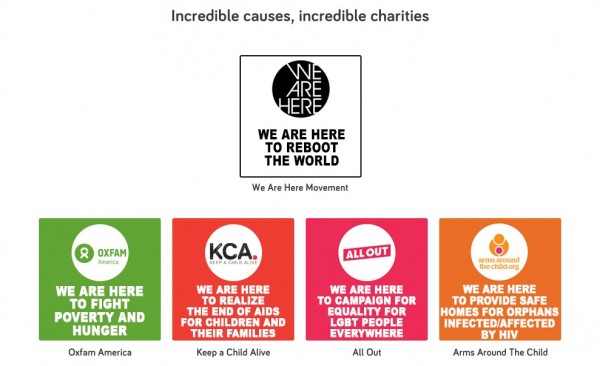
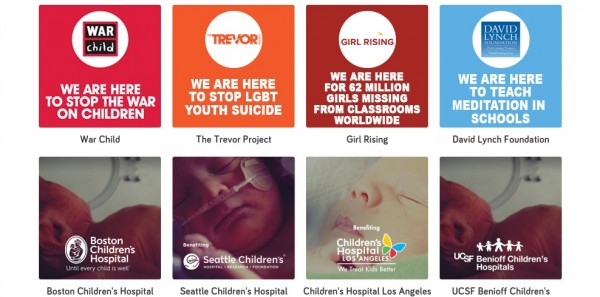

Registered runners and supporters receive an exclusive 20% discount on safe, bone conduction headphones from AfterShokz. Since this relay takes place on roadside courses, during all hours and conditions, runners won’t be allowed to use traditional headphones and earbuds that block out traffic and warnings. By contrast, AfterShokz bone conduction headphones ensures runners can remain aware of surroundings while they run. Plus, 5% of every purchase made will be donated to the United Relay of America Fund through June 2016.
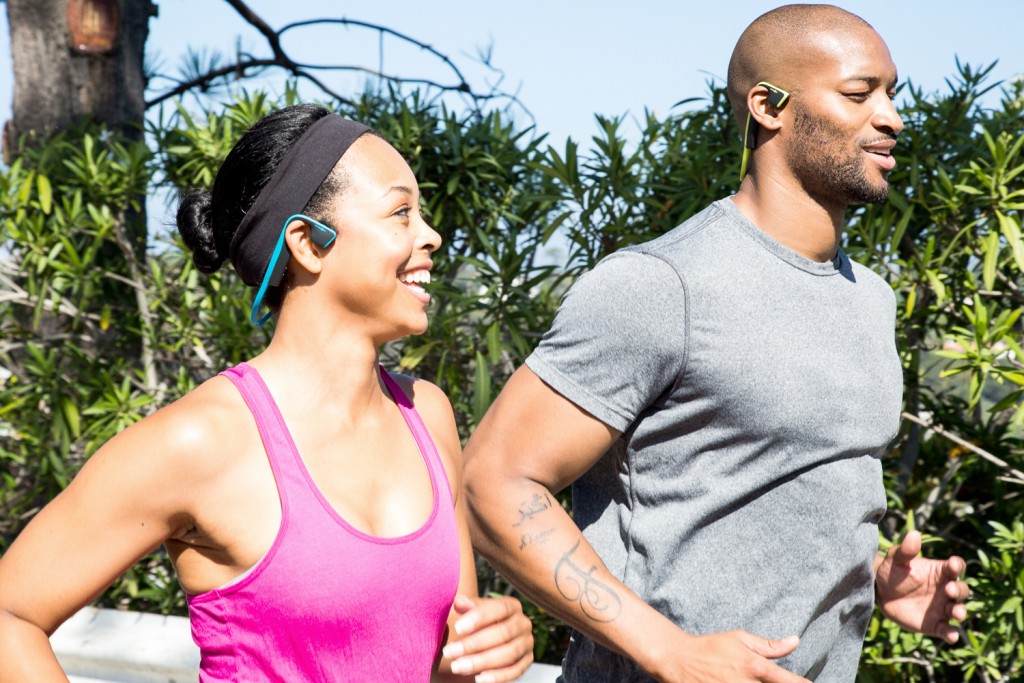
AND, when you sign up to a run a stage you’ll be automatically entered for a chance to meet Alicia Keyes, during a two-night stay in NYC with flights included! The winner and a friend will also receive a free pair of AfterShokz headphones and a goodie bag, including an exclusive United Relay t-shirt signed by Alicia Keys.
You can increase your chances of winning (each point represents a separate entry into the prize draw):
- 5 points for signing up to an empty stage
- 4 points for signing up to a Standard Stage
- 3 points for every $100 you raise
- 2 points for recruiting a friend to run
- 1 point for signing up to a Group Stage
You can see a running total of your points within your United Relay Dashboard.
I have to admit, I’ve been feeling some runner envy this month; so many people have been posting pictures as they kick off their racing season. This is a great opportunity to set a date to begin training for, while raising funds for a cause you care about— did I mention 100% of United Relay of America Fund proceeds go directly to the charities?
Register today!
read more
I’ve been taking a look at my diet lately, as I am wont to do at this time of year. I’ve been feeling heavy, foggy, generally grumpy. And like always when I do this, even though I try to be pretty good about what I eat, I’m legit shocked by the amount of sodium in my diet. Measurable sodium— we’re not even talking about what comes out of the shaker when I’m cooking.
Sodium is in just about everything, and in heaping amounts when it comes to processed or restaurant foods. That’s one of several very compelling reasons to start a diet overhaul by committing to preparing all of your own food at home.
90% of Americans are overdoing it on the sodium, by a lot: the recommendation is that we take in less than 2,300 milligrams (about a teaspoon of salt) per day, and we’re averaging about 3,400 mg daily. Kids, in particular, are susceptible to high sodium levels because of their near universal love of certain foods:
pizza, esp with meat toppings
bread and rolls
lunchmeat
cheese
chicken nuggets
canned anything
soups
chips and crackers
Most adults probably eat too many of those, too.
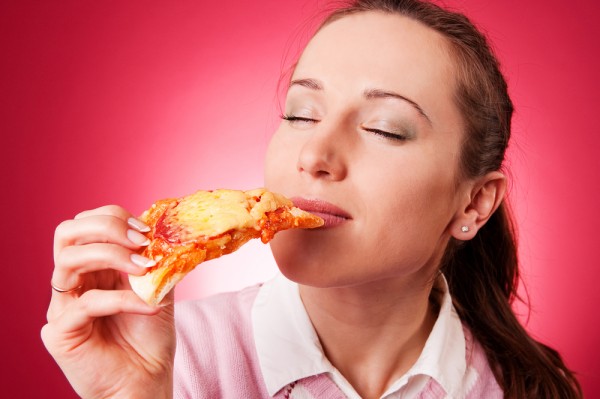
Mmm, pizza
Too much sodium can lead to increased blood pressure, which in turn increases your risk for heart disease and stroke: two of the leading causes of death in this country (heart disease is #1).
BUT, not getting enough sodium carries its own health risks, so don’t worry about cutting it out completely.
Best practices for healthy sodium levels:
- get out of the habit of using table salt entirely
- use salt sparingly while cooking; save it for those foods that really need it for flavor
- READ INGREDIENT LISTS!
- cut our processed foods as much as possible
- up your potassium intake by eating lots of leafy green vegetables, orange vegetables, bananas and citrus fruits. Potassium helps your body release sodium.

Here’s some tasty inspiration for your newly-formed resolve to reduce sodium intake! They’re also meat-free (technically, depending on where you stand on seafood as a meat) so possibilities for Meatless Monday menus.
These two recipes were created by the Executive Chef at Pritikin Longevity Center + Spa, Anthony Stewart.
Two No Sodium Recipes to Try
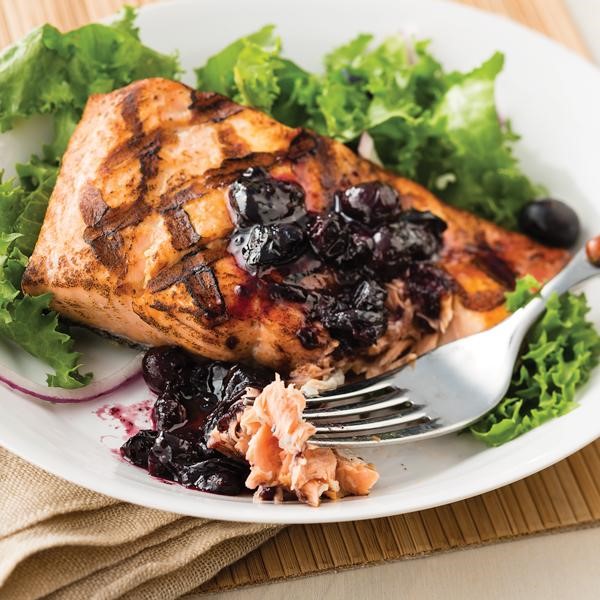
SEARED SALMON WITH BLUEBERRIES AND QUINOA
Serves 4
- ¾ cup uncooked quinoa
- ½ cup balsamic vinegar
- 2 cups fresh blueberries
- 4 four-ounce salmon fillets
Pre-heat grill to medium-high heat.
Bring quinoa and 1-1/2 cups water to a boil in a medium saucepan. Reduce heat to low, and cover and simmer until tender and most of the liquid has been absorbed, about 15 minutes.
While quinoa is simmering, pour balsamic vinegar and blueberries into a small saucepan. Bring to boil on the stove. Reduce heat and stir regularly under mixture is reduced by half, about 10 minutes. Remove from heat.
To grill salmon, place your fillets on grill rack lighted misted with oil spray, and directly over coals. Grill, uncovered, for 4 to 6 minutes per 1/2-inch thickness, or until fish begins to flake when tested with a fork. Turn the fish once halfway through grilling.
If your fillets still have skin, remove the skin after grilling.
On 4 individual plates, divide quinoa. Top with salmon. Top salmon with blueberry sauce. Garnish each plate, if desired, with a few fresh blueberries.

QUINOA AND CARROT SALAD
Serves 4 to 6
- ¾ cup uncooked quinoa
- 1 cup carrots, shredded
- 1 teaspoon garlic, finely chopped
- 1 teaspoon onion, finely chopped
- 1 teaspoon dried oregano
- 1 teaspoon fresh mint, finely chopped
- 2 tablespoons orange juice (or more, if desired)
- ½ seedless cucumber, chopped (optional)
Bring quinoa and 1-1/2 cups water to a boil in a medium saucepan. Reduce heat to low, and cover and simmer until tender and most of the liquid has been absorbed, about 15 minutes. Fluff with a fork. Let cool.
In a medium bowl, combine quinoa, carrots, garlic, and onion.
Add oregano, mint, and orange juice.
Add cucumber, if desired.
Toss to combine.
read more
Posted by Robin on Apr 1, 2016 in Fitness & Health | 0 comments
Today’s National Walking Day. It’s also April Fool’s Day, which is a holiday that I think should be taken out to the barn and shot, but never mind about that. Here in southeastern PA today is gloriously sunny and in the low 70s; temps are forecasted to retreat into the 40s this weekend with a possibility of snow (SNOW!). There’s never been a better day for a nice, brisk walk.
Here, I present unto you the health benefits of walking and most pressing reasons to put on some pants and get outside:

Walking gets your blood flowing.
A recent Ball State study found that Americans generally spend 64% of waking hours in a sedentary position. Now, granted, Americans also don’t get enough sleep, so there’s not a lot of not-waking hours, but it’s still a sobering statistic. Even if you’re going to the gym after work every day for an hour of exercise, that isn’t enough to counteract the adverse effects of sitting all day long. While in a seated position, your lungs aren’t expanding fully, your circulation is compromised (it’s even worse if you have bad posture) and therefore the amount of oxygen being moved throughout your body is lessened. This means physical weakening and mental fuzziness.
Whenever you get the opportunity throughout the day, you should get up and walk around, stretch, do something to get that blood flowing to rejuvenate your mind and body.
You’ll live longer.
Physical activity lengthens our telomeres, the caps at the ends of chromosomes that are tied to aging and stress. On the flip side, a sedentary lifestyle is connected to increased mortality rates, from reasons spanning from colon and breast cancer (one study indicated those who were inactive were 40% more likely to die from their cancers) to insulin resistance to stroke and heart attack.
You’ll feel better.
Sedentary people are more likely to be depressed, although it’s hard to say whether being inactive leads to depression or if those who are depressed are less inclined to be active. However, there’s a good body of evidence showing that the endorphins produced from exercise helps to lift spirits, and that being out in nature lowers blood levels in the parts of the brain associated with rumination. In other words, going outside for a walk forces you out of your own head so that you’re not dwelling on the negative; in fact it can instead bring on a meditative state with all its positive effects.
You’ll be more creative.
Walking exposes us to new stimuli and allows our minds to wander: these unfettered thought and associations are the perfect prescription for creativity. Meanwhile, the exercise distracts the prefrontal cortex (right brain thinking) letting the left side of the brain take over a bit, plus it increases that blood flow to the brain, enlarging the hippocampus (which moves information from short-term to long-term memory). One Stanford study found that walking increased creative output by 60%!
You’ll probably lose weight over time.
For those who are currently sedentary or aren’t already committed to a weight loss regime, walking is a great place to start. It’s easy on the joints. It doesn’t involve any special equipment, upfront costs or new skills. It’s low pressure and not as intimidating as walking into a weight room or Zumba class. And for most people, it’s sustainable because it’s enjoyable: a chance to get out into the open air, bask in the sunshine, catch up with a friend.
If just walking doesn’t feel like a significant enough form of exercise to make a difference, consider this: for those with obesity who are trying to lose weight, the greatest health benefits come from losing just 5 percent of their body weight: according to a new study, that relatively small weight loss notably lowered risk for diabetes and cardiovascular disease. It also improved metabolic function in liver, fat and muscle tissue.
To get the most weight loss benefits from walking, you’ll want to keep the pace brisk and heart rate elevated. Also, try walking immediately after meals— it helps to slow digestion and improve your circadian rhythyms (messed up circadian rhythms can make it more difficult for your body to let go of fat). And yes, you will need to look at your calorie intake. All the walking in the world can’t overrule basic math.
It’s just nice.
It IS.
I know it’s so much easier to stay where you are. But going for a walk is such a simple pleasure. Why deprive yourself of that, especially when it’s so good for you?
read more
Posted by Robin on Dec 17, 2015 in Fitness & Health | 0 comments
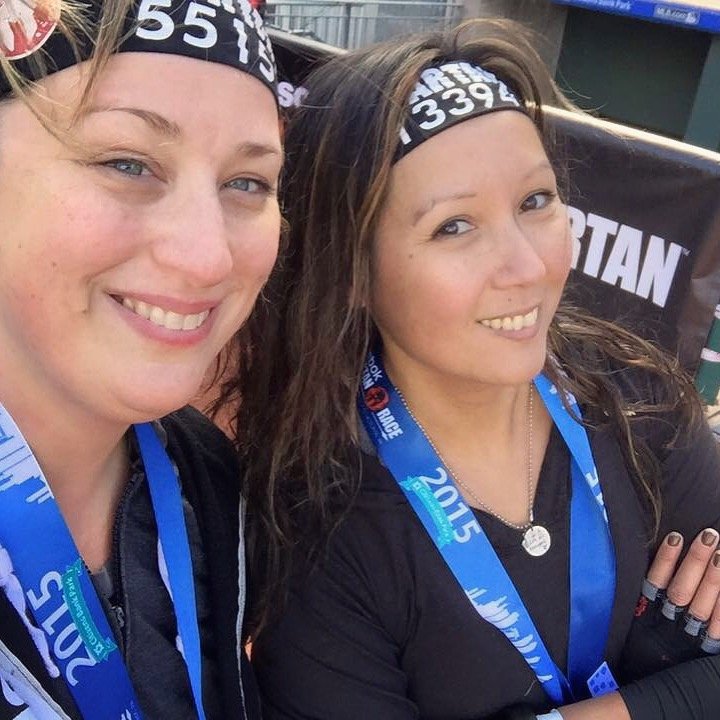
For the third year in a row, we ran Spartan Race Citizens Bank Park, and for the third year in a row, we were totally not prepared for it.
The first year we just didn’t know what to expect. The past two years we just didn’t train properly, despite the best of intentions, so it felt harder than it needed to be and I knew perfectly well I coulda shoulda done a whole lot better.
Don’t we look happy and accomplished in that picture up there? Yeah. This picture here is a more accurate representation of how I felt most of that day.

Miserable. It was cold and windy and that stadium is like a wind tunnel. By the time it came for us to run, we’d been frozen stiff; it literally took half the race before my legs started to feel warmed up properly.
The wait did mean we got to spectate a bit, which was nice. Amazingly, I happened to notice when one of our CrossFit coaches went across the monkey bars— that’s her with her hair in a bun, in the middle.
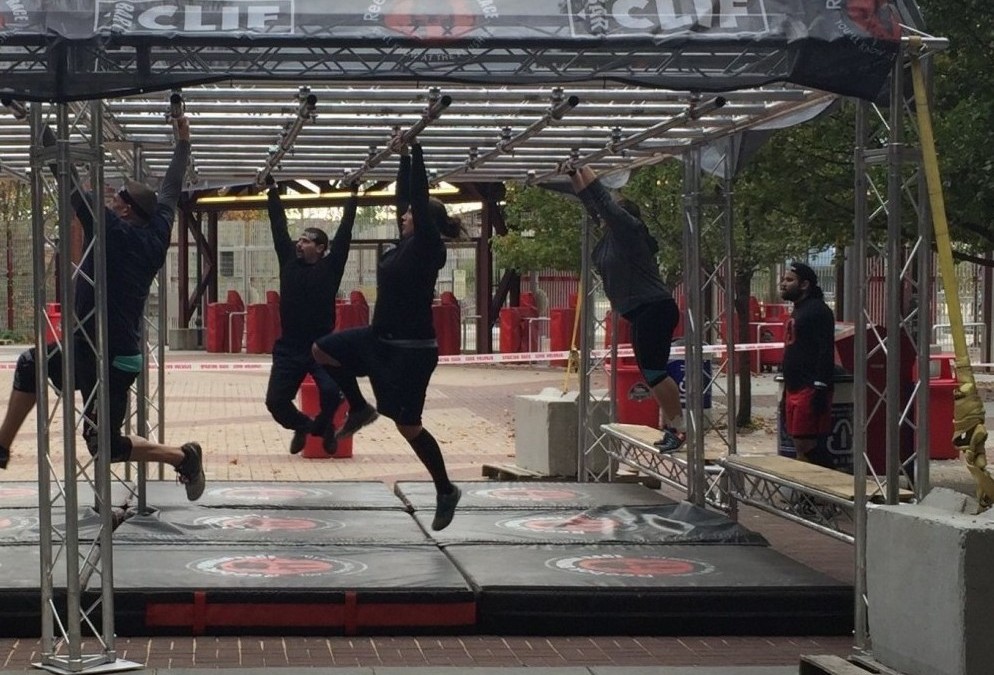
Those monkey bars are no joke. They’re wide in diameter and far apart, and you have to be careful to keep your feet off the mats. Touch down and you’re done.
After cheering Coach Mik across the monkey bars we went and waited for her to deal with the traverse wall. This sucker is one of many obstacles at Spartan Race that is harder than it looks; it requires a fair amount of finger grip strength and getting around the curves is rough.
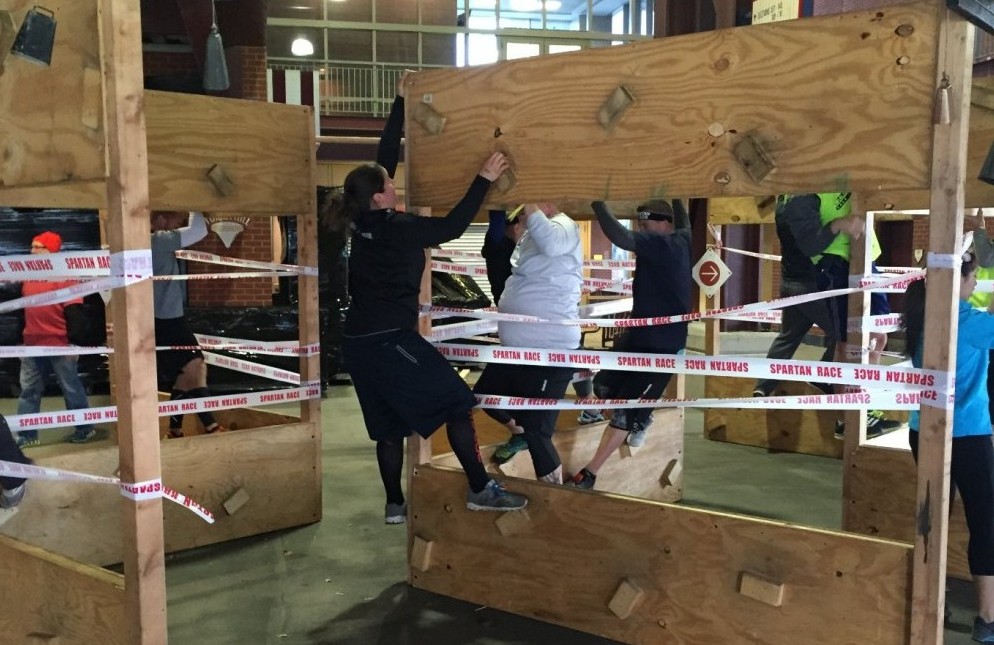
Another deceptive obstacle, a new one this year. It looked like it was going to be fun. All you had to do was keep your feet on the skates and “walk” across on your hands, spin around, then come back the same way.
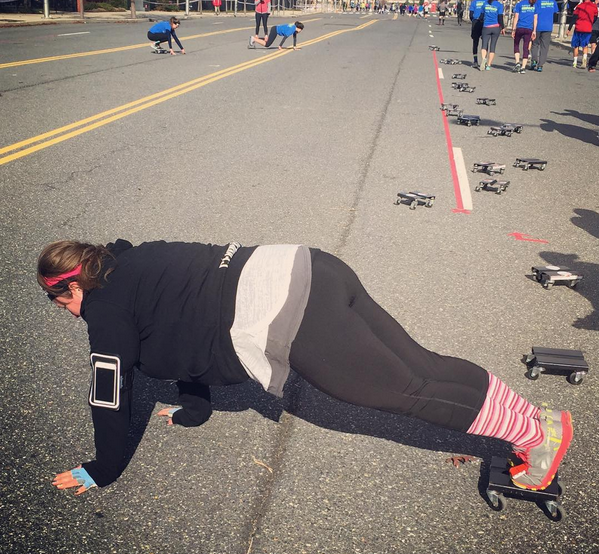
But, the wheels were like the ones on shopping carts in that they swung every which way, and liked to pull hard to the left, and sometimes my feet would randomly overrun my hands. It was not easy.
I guess it was sort of fun.
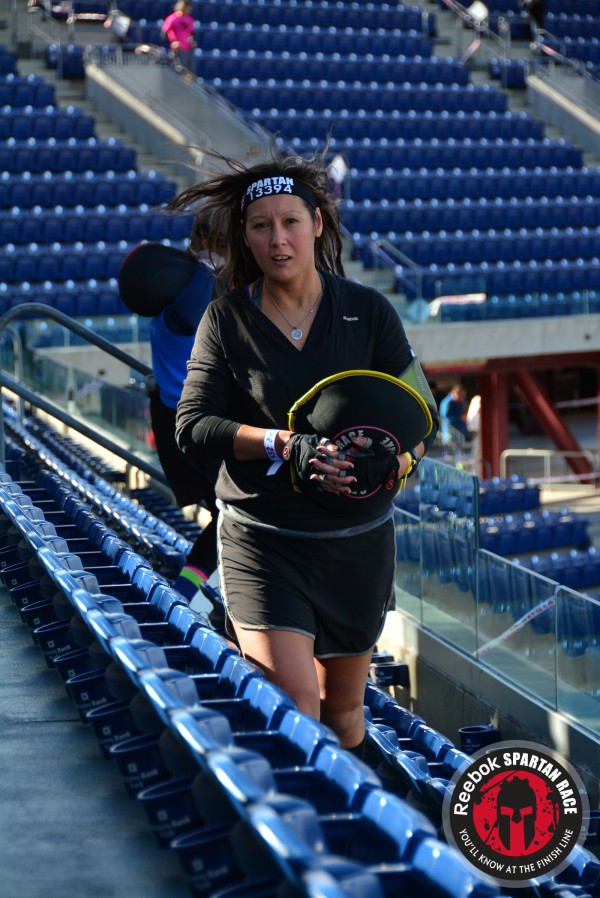
Seriously, I look like a psycho. A cold, windblown, miserable psycho.
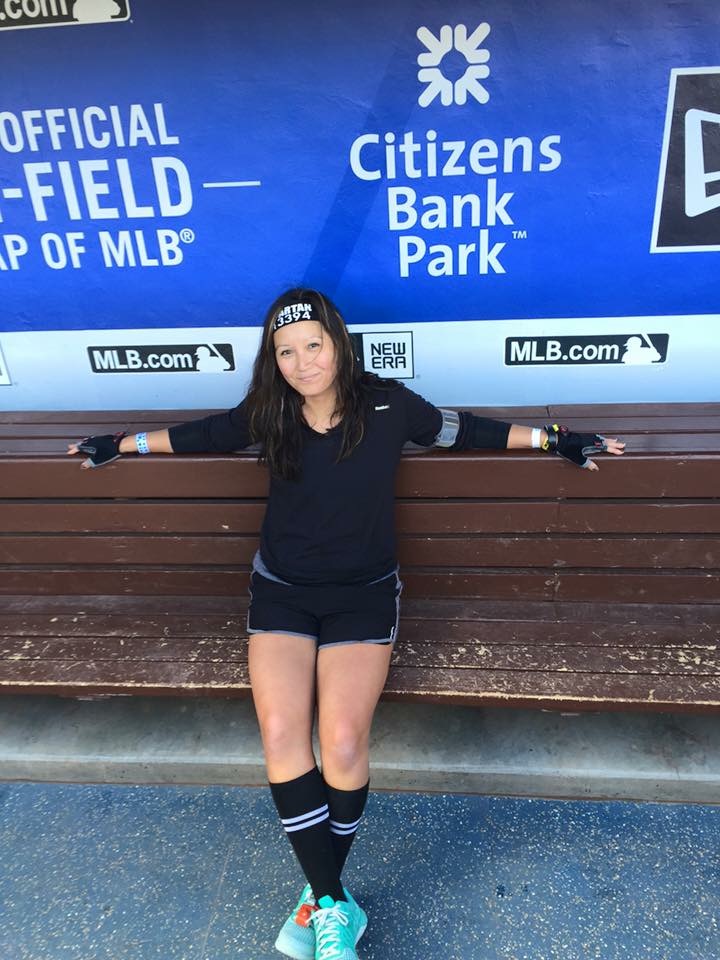
My yearly dugout photo. I look happy here because I’m out of the wind and in the homestretch.

I really struggled with the walls this year, which is disappointing because I don’t usually. My upper body strength is not where it used to be.
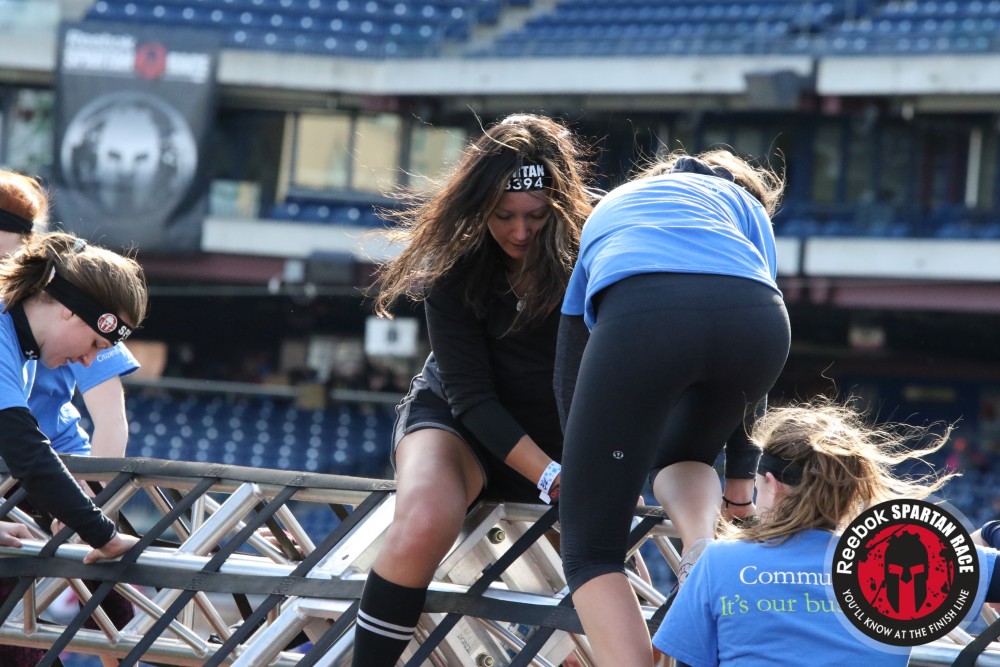
And for the third year in the row I still didn’t ring that damn bell at the top of the rope. I’ve got the technique pretty much down, but I get scared at a certain point. Also, the knots actually make it harder and these ropes are well worn; the ones at my gym have a lot more grip to them.
I don’t know. Next year, I hope.
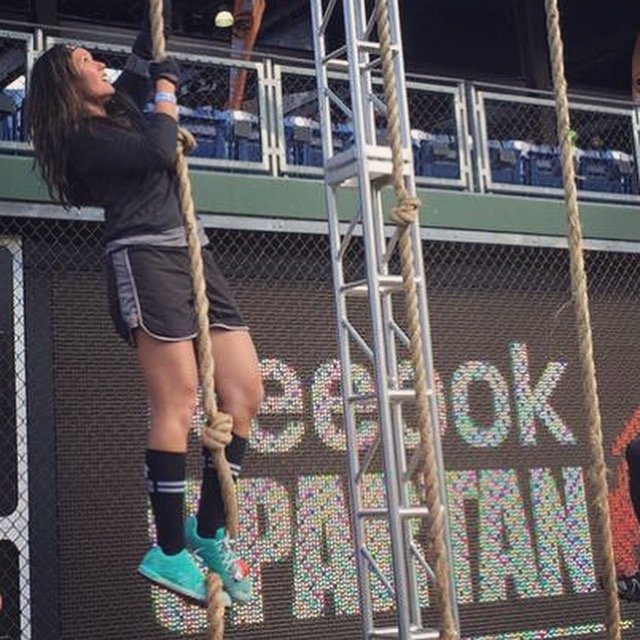
Another year down. I’d say I gave a solid… like… 65% of my best effort. So if you’re wondering if you can manage Spartan Race, the answer is YES. Yes, you can, and you should. Because even though it was cold, and miserable, and I wasn’t ready, I enjoyed it as always.
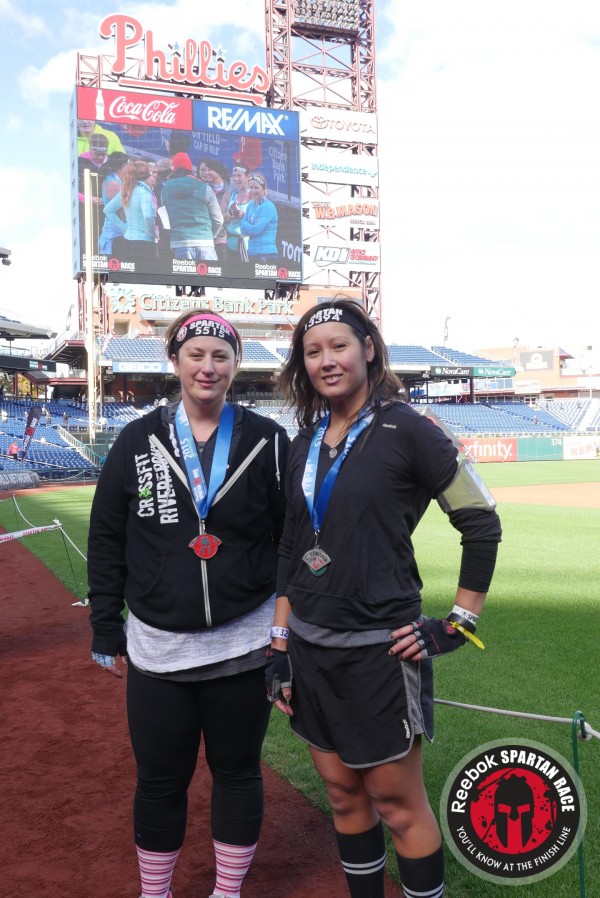
More details on Spartan Race obstacles at stadium races here.
Rope climbing techniques and other ways to prep for Spartan Race obstacles here.
read more
Posted by Robin on Nov 5, 2015 in Fitness & Health | 2 comments
Last weekend we “fell back” for Daylight Saving, the unofficial start of Seasonal Affective Disorder season as we are forced to cope with shorter days, longer evenings.
My Honey Badger Revolution co-contributor intimately describes how SAD affects her here; going through old posts on my green blog I can hear my enthusiasm for nature, exercise, being outside, writing, or life in general being tuned way down as soon as November hits. It’s really hard to enjoy fall, beautiful as it is, when you’re all too aware that the starkness and isolation of winter follows.
She and I are far from alone. Between 4% and 6% of Americans suffer from Seasonal Affective Disorder; an additional 10-20% experience a milder winter-onset SAD. Three of four SAD sufferers are women.

Seasonal affective disorder is a subtype of major depression that comes and goes based on seasons. So symptoms of major depression may be part of SAD, such as:
- Feeling depressed most of the day, nearly every day
- Feeling hopeless or worthless
- Having low energy
- Losing interest in activities you once enjoyed
- Having problems with sleeping
- Experiencing changes in your appetite or weight
- Feeling sluggish or agitated
- Having difficulty concentrating
- Having frequent thoughts of death or suicide
Fall and winter SAD
Symptoms specific to winter-onset SAD, sometimes called winter depression, may include:
- Irritability
- Tiredness or low energy
- Problems getting along with other people
- Hypersensitivity to rejection
- Heavy, “leaden” feeling in the arms or legs
- Oversleeping
- Appetite changes, especially a craving for foods high in carbohydrates
- Weight gain
A SAD diagnosis is likely if you’ve gone through this at least three times and your symptoms go away in spring and summer. (If anything, I become a bit manic in the spring. And if you asked my family to describe me right now this list would be frighteningly accurate.)
If you’ve recognized a pattern of SAD in your life, a visit to your doctor is in order. They can talk you through treatments and if necessary prescribe something to smooth out the rough patches. There is no shame in not wanting to be depressed, much like there is no shame in tapping out on fully experiencing the pain of childbirth. I’ve weathered both and it doesn’t make me any better than anyone else. There’s no need to play the hero here, and the longer you wait the harder it will get to seek treatment.
Some years have been better than others for me. I think the severity of the weather probably plays a part, and it’s possible I’m “growing out of it”— it appears that the risk of SAD lessens as you age. But I thought it would be helpful to share the common sense steps I take to fight Seasonal Affective Disorder every year; some are backed by science, some may be no more than the placebo effect, but that’s ok with me. Whatever works, right?
In full disclosure, I’ve included some Amazon affiliate links to the products I use below; if you decide to click through and buy anything, I’ll get a few cents on the dollar.
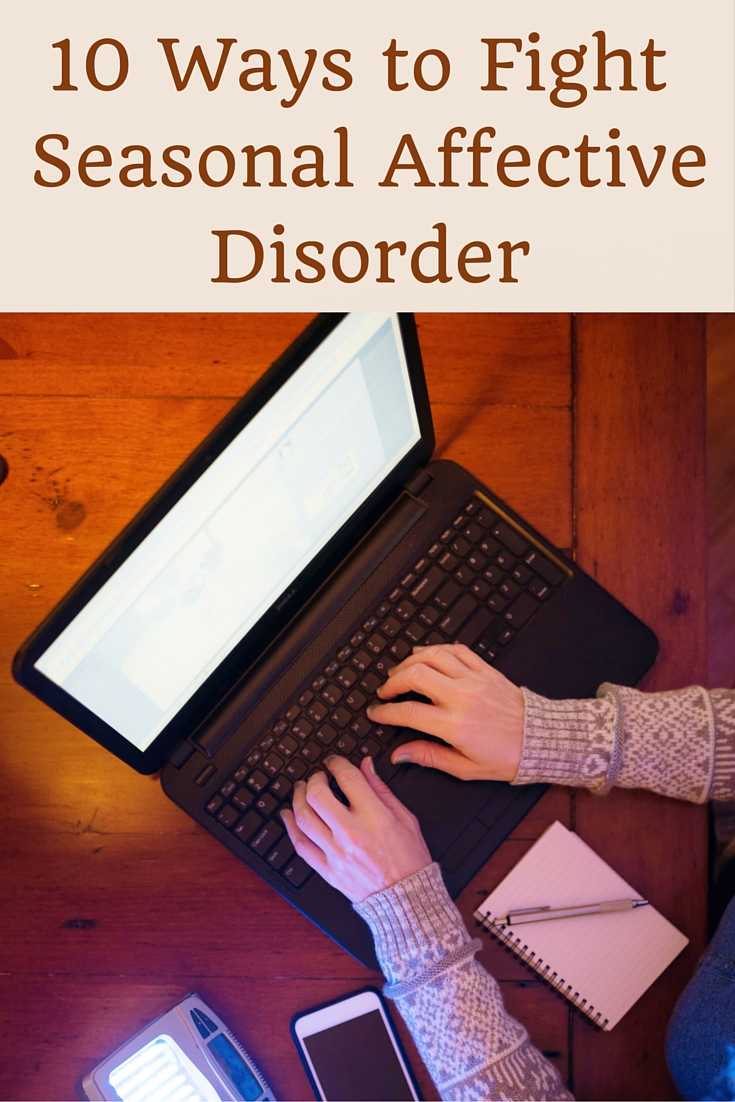
Blogging/Journaling
If I’ve learned anything after nearly a decade of blogging, it’s that my seasonal sadz are so cyclical and predictable I can practically set a watch by them. By Thanksgiving I’m cranky and already tired of the Christmas chaos. I tend to rally some Yuletide cheer and hope for the future for the last week of the year, then go silent for a while other than to bitch about a groundhog and the nonsense that is Valentine’s Day. March is always rough. After months of being cold and unmotivated, the relentless grey rain of March nearly breaks me every year.
Obviously I didn’t start blogging to track my depressive symptoms, but being able to see my mood change predictably year to year has been very helpful; it gets me through the worst of it knowing that relief will come in the spring.
Phototherapy
SAD is likely caused by our circadian rhythms being thrown out of whack from less exposure to sunlight (exacerbated by Daylight Saving and the fact that most people spend these shortened daylight hours in a windowless corporate environment).

I turn on this Seasonal Affective Disorder light in the morning for 20 minutes or so before I wake my daughter up and it definitely jolts me awake physically and mentally; I’m not nearly so tempted to nap and massively screw up my sleep cycle even more. It’s small, so I can move it from room to room; you could also easily toss it into a carry-on bag for traveling.
Outdoor Time and Vitamin D
Vitamin D is the “sunshine vitamin,” and studies suggest that about half of the world’s population is Vitamin D deficient. Research also indicates a link between D deficiency and depression, although causality isn’t certain (does the deficiency make us depressed, or does depression somehow render us unable to absorb or use the vitamin?). Given that SAD is linked to less exposure to sunshine and disrupted circadian rhythms, plus the general health benefits of being in nature, it makes sense to make an effort to soak up the sun as much as possible during the fall and winter months.
Keep in mind that you don’t reap the same benefits sitting inside in a splash of sunlight; sunshine doesn’t penetrate glass that way. Nor can it penetrate properly applied sunscreen. Also, the angle of the sun is different at this time of year and depending on how far north you are, you may need more time in those rays.
Be conscious of how much vitamin D you get via your diet (eggs with yolks and fatty fish like salmon, mackerel and tuna) and consider a supplement as well.
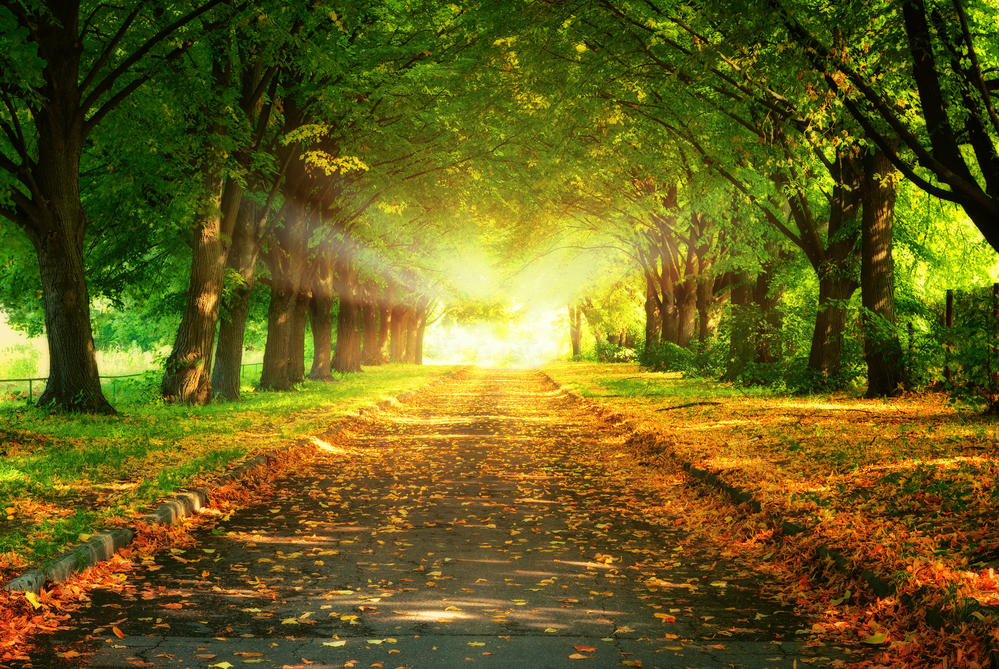
Get Up, Stay Up
DON’T HIT THE SNOOZE BUTTON.
I know, it’s so freaking hard to get up in the morning when you’re not feeling awesome, and that goes double triple when it’s cold and dark. But hitting the snooze button just adds another layer of dread to your morning, and every time it goes off your adrenaline goes through the roof. When you drift off for a couple of minutes only to be jolted awake again, you’re pulling your brain and body out of sleep during a disadvantageous period, causing a sleep inertia that can take hours to recover from. That means sluggishness, impaired memory, poor decision making, disruption of your body’s circadian rhythms and pretty much wasting your morning and making you feel bad about your life.
The ideal situation here is to wake up naturally at the end of an REM cycle— when I’m in a good sleep routine, I find I wake up a minute or two before the alarm. Since most of us have a non-negotiable time we need to be up by, start with that, count backwards 7 hours, and then keep pushing your bedtime a little earlier until you find your sweet spot.
Once it’s time to get up JUST GET UP. I swear, it’s worth it.
Other Vitamins
The studies on taking vitamin supplements are mixed— generally speaking, people who take vitamins tend to be healthier overall, but that may be because if you’re the type of person who dependably takes a vitamin, you probably also have other healthy habits in place. So in theory you should aim to be the type of person who takes vitamins but save the money.
That said, I like to think of myself as a vitamin taking type but if I’m being honest I know my day-to-day diet is lacking. I take a multi and during the fall and winter months I’ll also take additional supplements on the days that I remember. (Worth noting: I take them in gummy form because I hate pills.) These are the ones I felt made a difference in regards to Seasonal Affective Disorder.
- Magnesium deficiency is another state that is linked to depression and anxiety. Magnesium suppresses the release of stress hormones from the hippocampus and can help block stress hormones into the brain; stress causes us to waste the magnesium we do have. Magnesium also helps reduce blood pressure and keeps your digestive system moving. Good food sources are nuts and seeds, dark green veggies like broccoli and spinach, whole grains, bananas. I’ve not yet found a gummy magnesium; I go with Nature Made for this one.
- Vitamin B12 helps to regulate the nervous system, and deficiency has also been linked to depression and stress. It’s needed to convert carbs into glucose— so taking B12 serves to fight fatigue and increase energy. Vitamin B12 is found in animal foods, so meat, dairy, fish, eggs. Also, these gummy B12 vitamins are my favorite. They’re really tasty.
- Melatonin regulates your sleep and wake cycles; levels in your body are affected by the amount of light you receive. Not enough light leads to lowered melatonin, which leads to disrupted circadian rhythms and, you guessed it, depression. Taking melatonin 20 minutes before bedtime helps you to fall asleep faster and stay asleep better; better sleep almost always makes for a better morning. I don’t take these all the time, just at the beginning of the season or on nights I suspect I’m going to have a hard time falling asleep for whatever reason.

Exercise Often
Exercise clears your head and releases those feel good hormones short term, and pushes you to feel better about yourself when you stick with it long term. It helps us to sleep better and can strengthen circadian rhythm, although you may need to experiment to find the best time of day for you (some people will find it harder to fall asleep too soon after exercising). AND, a pertinent Seasonal Affective Disorder benefit: exercising for one hour outside, even under cloudy skies, is as beneficial as 2.5 hours of indoor light treatment.
Get Dressed to Shoes
This is a phrase I learned from the FlyLady a long time ago and it’s always stuck in my mind. I can’t quite remember her exact reasoning for it, but here’s mine:
- The best part of going to a party is choosing what to wear and getting ready to go.
- When you look good you feel good.
It’s soooooo easy to fall into a trap of not caring what you look like because you have nowhere to go and no one to impress, and next thing you know you feel like hell because you haven’t showered in days and it feels like such an effort to even bother. Nope. Put some thought into an outfit— not just your cleanest sweats— including some kickass shoes. Do your face and hair. Even if, maybe especially if, you have no place to go.
Are the days of winter sunshine just as sad for you, too? When it is misty, in the evenings, and I am out walking by myself, it seems to me that the rain is falling through my heart and causing it to crumble into ruins.
―Gustave Flaubert
Now Go Somewhere
You need that sunshiney outdoor time, remember? But I’m taking it a step further. Plan out your week and put something outside of the house on the schedule for every day. It doesn’t have to be a big deal: go to a park to take pictures, hit the library and take out some magazines, try a new takeout place, visit a museum, see a movie. One or more should be plans with friends or family so you can’t back out. Exercise counts but you need to mix it up— 30 minutes doing the same thing at the gym every day doesn’t break up the monotony effectively. At least twice a month there should be something you’re genuinely looking forward to.
For me, the real slide into depression comes when the days all feel the same and start running into each other and the voice I hear most is the one inside my head. The inertia becomes more and more difficult to overcome and at my worst I become overwhelmed by fullblown agoraphobia.
Maybe you won’t get out every day as planned, and that’s not something to add to your plate of self-recrimination. We all have off days. The act of planning reminds you that it’s in your power to keep moving, and that you deserve to enjoy yourself, and that it doesn’t take a whole lot to add something good to your day. But a whole lot of the time, it does help your mindset if you literally change your perspective.
Three Things; A Feeling of Gratitude
Speaking of changing perspective…
As human beings, we’re not hard wired to be sunshine and rainbows all the time; Seasonal Affective Disorder magnifies that. In Flourish: A Visionary New Understanding of Happiness and Well-being , Martin Seligman says that
, Martin Seligman says that
For sound evolutionary reasons, most of us are not nearly as good at dwelling on good events as we are at analyzing bad events. Those of our ancestors who spent a lot of time basking in the sunshine of good events, when they should have been preparing for disaster, did not survive the Ice Age. So to overcome our brains’ natural catastrophic bent, we need to work on and practice this skill of thinking about what went well.
Studies have shown that a daily ritual of practicing gratitude can chip away at depression. It makes sense; when you consistently look at the down side of events, it becomes habitual; you physically carve a neural pathway. It takes a lot of work to carve a new one, to have a less dismal outlook become your default. It’s a skill that requires training.
It’s suggested that you keep a gratitude journal where you list three things you are grateful for, or three things that went right that day, before you go to bed. It’s going to feel dumb but I promise you’ll get used to it. Or, another idea along the same vein is Gretchen Rubin’s One Sentence Journal, which gives you a quote to reflect on each day and then you write one sentence about your day. The nice thing about her journal is that it goes for five years but you return to the same page each year, so you can quickly see how much you change, how much you stay the same.
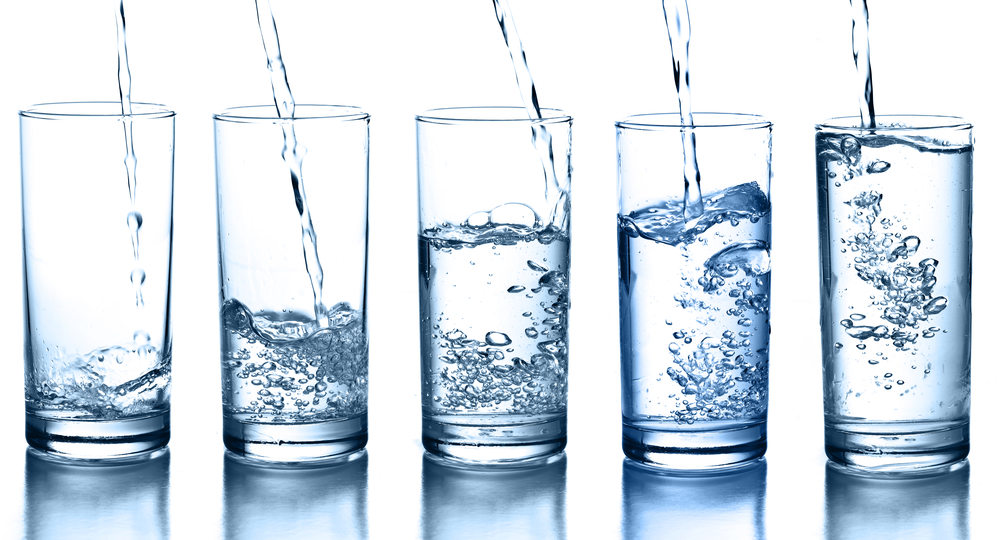
Drink Lots of Water and Limit Alcohol
I like a glass of wine or bottle of beer as much as anyone, but while it can take the edge off the sadz it’s seriously not your friend. Alcohol can intensify emotion or dull your existence even further. It makes you foggy in the morning. It can pull you deeper into isolation. It inhibits your ability to absorb or activate Vitamins D, B12 and magnesium. And it can disrupt your restful sleep and your body’s response to light and dark (therefore affecting circadian rhythms).
Being dehydrated can lead to fatigue, mental fuzziness and perceiving everything as more difficult. It can increase tension, moodiness and anxiety, and these changes are more acutely felt in women. I always chug a big glass of water before bed because I feel like crap in the morning and it’s a struggle to get out of bed if I don’t.
60% of your body is water. Your brain is about 75% water. Water moves nutrients around the body and flushes out toxins. This is one of the easiest changes to make to feel better and yet, for me, one of the hardest.
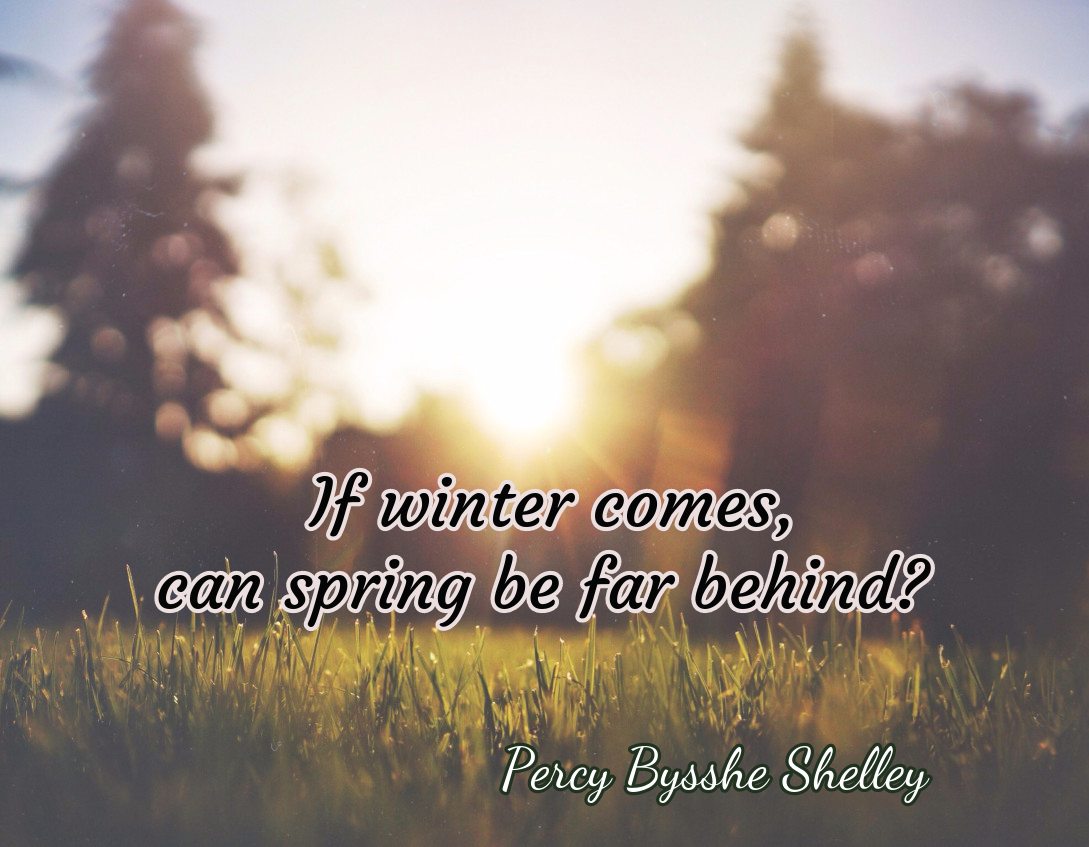
Hang in there. You are not alone.
I want to stress again: if you’re suffering from depression, seasonal or otherwise, please talk to your doctor about it. I find mine to be manageable now, but I spent many years struggling with crushing sadness and paralysis, and self-loathing from feeling that way. If I could go back and be counseled on a way to avoid that, I would.
Depression is real and not to be taken lightly. I’ve been through enough cycles at this point in my lifetime that I now usually recognize the signs that I’m in danger of sliding down deep. These are just the common sense ways I employ to stay above the waterline throughout the year, and I double down through the fall and winter.
If you have more tips for fighting Seasonal Affective Disorder, I’d love to hear them.
Sources:
10 Health Benefits of Sunshine
Are You Getting Enough Vitamin D?
Is the snooze button bad for you?
Magnesium and the Brain: The Original Chill Pill
Treatment for Seasonal Affective Disorder (SAD)
Is Alcohol Disrupting Your Sleep?
Dehydration Influences Mood, Cognition
read more

































